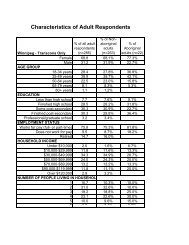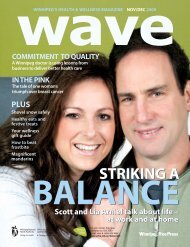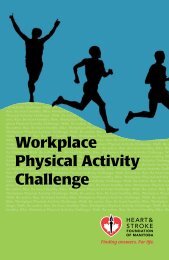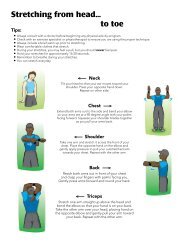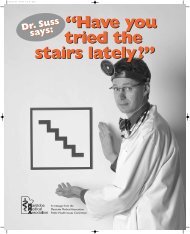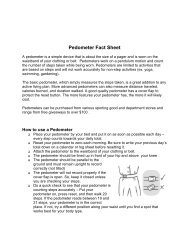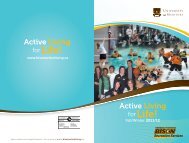Wave: March / April 2010 - Winnipeg in motion
Wave: March / April 2010 - Winnipeg in motion
Wave: March / April 2010 - Winnipeg in motion
You also want an ePaper? Increase the reach of your titles
YUMPU automatically turns print PDFs into web optimized ePapers that Google loves.
About Dr. Brian Blakley<br />
As an otolaryngologist with the <strong>W<strong>in</strong>nipeg</strong><br />
Health Region, Dr. Brian Blakley<br />
treats patients with a variety of hear<strong>in</strong>g<br />
problems. But he’s also conduct<strong>in</strong>g<br />
research <strong>in</strong>to new ways of help<strong>in</strong>g<br />
people rega<strong>in</strong> their hear<strong>in</strong>g or prevent<br />
hear<strong>in</strong>g loss altogether.<br />
“My projects are translational, what I<br />
like to th<strong>in</strong>k of as tak<strong>in</strong>g basic science<br />
and apply<strong>in</strong>g it cl<strong>in</strong>ically to humans,<br />
which is a big need right now,” says<br />
Blakley.<br />
For example, Blakley is currently<br />
look<strong>in</strong>g <strong>in</strong>to whether antioxidants can<br />
help reduce the onset of hear<strong>in</strong>g loss.<br />
“We have shown, <strong>in</strong> mice, that if you<br />
give them antioxidants early <strong>in</strong> life –<br />
the equivalent <strong>in</strong> human terms of their<br />
teens – that you can delay the onset<br />
of presbycusis (the gradual loss of<br />
hear<strong>in</strong>g attributed to a loss of elasticity<br />
<strong>in</strong> the ear drum).”<br />
Blakley is also look<strong>in</strong>g at whether<br />
diets high <strong>in</strong> omega-3 fatty acids can<br />
stem hear<strong>in</strong>g loss. “That’s just been<br />
go<strong>in</strong>g on for a few months, so I don’t<br />
know how that is go<strong>in</strong>g to turn<br />
out.”<br />
A third project <strong>in</strong>volves test<strong>in</strong>g<br />
whether nerve growth hormones<br />
can be used as a treatment for<br />
hear<strong>in</strong>g loss. “We have some<br />
promis<strong>in</strong>g data. The reason I like<br />
this one is that it will be an actual<br />
treatment for hear<strong>in</strong>g loss once<br />
it is established, as opposed to a<br />
pill that you have to take all of your<br />
life.”<br />
The Department of Otolaryngology<br />
is located with<strong>in</strong> the Health Sciences<br />
Centre and provides cl<strong>in</strong>ical services<br />
and academic functions for ear, nose<br />
and throat for Manitoba. In addition<br />
to general otolaryngologists,<br />
the department has sub-specialists<br />
<strong>in</strong> otology, head and neck cancer,<br />
pediatric otolaryngology and<br />
s<strong>in</strong>us surgery. The department<br />
serves about 120,000 patients<br />
a year.<br />
The problems associated with the<br />
<strong>in</strong>fection were now under control, but by<br />
this po<strong>in</strong>t Slykerman had suffered an approximate<br />
50 per cent hear<strong>in</strong>g loss <strong>in</strong> the<br />
<strong>in</strong>fected ear. Her left ear had also suffered<br />
<strong>in</strong>fections and “was far from 100 per cent”<br />
as well.<br />
At the time, Slykerman used a common<br />
hear<strong>in</strong>g aid to enhance her hear<strong>in</strong>g. Very<br />
quickly, however, she discovered the hear<strong>in</strong>g<br />
aid was no solution. She could not hear<br />
clearly through the aid and it was extremely<br />
uncomfortable to wear.<br />
Frustrated and resigned, Slykerman lived<br />
with her hear<strong>in</strong>g impairment for the next<br />
decade. “At the time I thought, ‘This is the<br />
way it’s gonna be,’” she confides. “I just<br />
tried to accept my circumstances.”<br />
But eventually, the impairment took an<br />
even greater toll. By the time she was <strong>in</strong><br />
her 30s, Slykerman decided to head back<br />
to university, <strong>in</strong>tent on complet<strong>in</strong>g her nurs<strong>in</strong>g<br />
degree at the University of Manitoba.<br />
Professionally, Slykerman had found herself<br />
<strong>in</strong> an unhappy dilemma: although she had<br />
found ga<strong>in</strong>ful employment as a registered<br />
nurse follow<strong>in</strong>g graduation from Red River<br />
College, her lack of a baccalaureate meant<br />
she had far less portability with<strong>in</strong> her<br />
profession. “I was so beh<strong>in</strong>d the eight ball,”<br />
Slykerman says. “It was a horrible feel<strong>in</strong>g.”<br />
Upon enter<strong>in</strong>g the U of M’s baccalaureate<br />
prepared registered nurs<strong>in</strong>g program,<br />
however, she quickly recognized the<br />
hurdles she faced were higher than ever.<br />
“I was terrified. The coursework was far<br />
more demand<strong>in</strong>g now. And without a tutor<br />
like I had at Red River, I was at a double<br />
disadvantage.” She would have to attend<br />
classes with a friend who could decipher to<br />
some extent what was be<strong>in</strong>g discussed <strong>in</strong><br />
the lecture room.<br />
Slykerman managed to struggle through<br />
most of her courses, until only four<br />
rema<strong>in</strong>ed. However, she recognized she<br />
simply couldn’t complete these under the<br />
same conditions. “Stats and nurs<strong>in</strong>g research<br />
methods – I really needed to be on<br />
the ball for these subjects.” In her estimation,<br />
the way she’d been work<strong>in</strong>g was just<br />
not adequate for the task that rema<strong>in</strong>ed.<br />
Her desire to complete a nurs<strong>in</strong>g degree<br />
was but one important event <strong>in</strong> Slykerman’s<br />
life that motivated her to seek help<br />
for her hear<strong>in</strong>g impairment. The other was<br />
the serendipitous arrival <strong>in</strong> her mailbox of<br />
a flyer from the Canadian Hard of Hear<strong>in</strong>g<br />
Association.<br />
By this time, Slykerman had become<br />
more and more socially withdrawn. Unable<br />
to f<strong>in</strong>d a hear<strong>in</strong>g aid that fit her particular<br />
needs, she quit wear<strong>in</strong>g one altogether,<br />
which meant she was not able to hear<br />
everyth<strong>in</strong>g that was go<strong>in</strong>g on around her.<br />
“Now I’m not completely deaf, but I’m<br />
<strong>in</strong> a really bad state. Fortunately, I had a<br />
job that allowed me to function well at<br />
my desk. When she went to meet<strong>in</strong>gs, she<br />
participated by simply try<strong>in</strong>g to anticipate<br />
what others were say<strong>in</strong>g.<br />
Then she read a newsletter from the Canadian<br />
Hard of Hear<strong>in</strong>g Association, which<br />
described hear<strong>in</strong>g loss as “the <strong>in</strong>visible<br />
disability” and asked for volunteers to jo<strong>in</strong><br />
the board.<br />
32 WAVE




